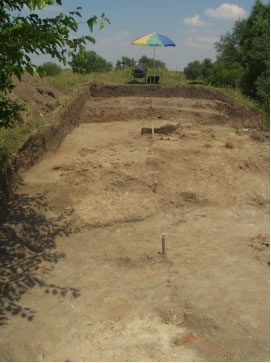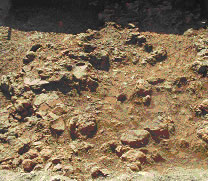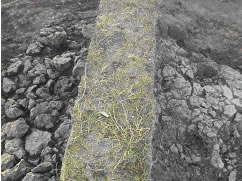The research team: Gheorghe Lazarovici (University "E. Murgu, Resita"), Dan Ciobotaru (Banat Museum, Timisoara) Marco Merlini - Lucian Blaga" University, Sibiu, EURO INNOVANET/Rome; Paola Ucelli Gnesutta (Pisa University), Zoia Maxim (National Historical Museum of Transylvania, Cluj-Napoca), Cornelia-Magda Lazarovici (Institute of Archaeology, Iasi), Dorel Micle (Western University, Timisoara), Sorin Petrescu, Dimitrie Negrei (Caransebes Museum); Cristian Roman ("Corvinian Castel" Museum, Hunedoara), Adela Mates (Beclean Museum), Mircea Ardelean (Western University Timisoara, Geographical Department).
In 2006 we have continued the archeological research at House of the Deer; ten years ago we have start to investigate this area and after a delay, we restart the investigation in 2005 (Lazarovici Gh., Merlini M. et alii 2006). Our area of research have been extended along the Timis river, in squares 172-182B-E, where the complexes discovered before, partially investigated continue, P 169 and from older excavations rooms A and B (in these cases we focus on the floor structure and on the basic structure of the dwellings) (Lazarovici Gh., Merlini M. et alii 2006; 2006a).
 In 2006 we have continued the archeological research at House of the Deer; ten years ago we have start to investigate this area and after a delay, we restart the investigation in 2005 (Lazarovici Gh., Merlini M. et alii 2006). Our area of research have been extended along the Timis river, in squares 172-182B-E, where the complexes discovered before, partially investigated continue, P 169 and from older excavations rooms A and B (in these cases we focus on the floor structure and on the basic structure of the dwellings) (Lazarovici Gh., Merlini M. et alii 2006; 2006a). In 2006 we have finished the investigation of the area belonging to levels Parta 6 and 7c. On all open area started in 2005 we finished the investigation of the rooms A, B, C, D and E, from the area of Deer House (Lazarovici et alii 2001, tome I.1, 2001, p. 146-148). On 7c level, in square 156-170 B-E it was another room with storey, extended to the N, first name as room E. The S wall of this room was investigated (it was discovered on 2 m large); we believe that this room belong to another "block "of houses, previous researched (Ibidem, P 151-153).
In 2006 we have continued the archeological research at House of the Deer; ten years ago we have start to investigate this area and after a delay, we restart the investigation in 2005 (Lazarovici Gh., Merlini M. et alii 2006). Our area of research have been extended along the Timis river, in squares 172-182B-E, where the complexes discovered before, partially investigated continue, P 169 and from older excavations rooms A and B (in these cases we focus on the floor structure and on the basic structure of the dwellings) (Lazarovici Gh., Merlini M. et alii 2006; 2006a). In 2006 we have finished the investigation of the area belonging to levels Parta 6 and 7c. On all open area started in 2005 we finished the investigation of the rooms A, B, C, D and E, from the area of Deer House (Lazarovici et alii 2001, tome I.1, 2001, p. 146-148). On 7c level, in square 156-170 B-E it was another room with storey, extended to the N, first name as room E. The S wall of this room was investigated (it was discovered on 2 m large); we believe that this room belong to another "block "of houses, previous researched (Ibidem, P 151-153).
We stop our last excavation here in squares 172 C-E, on level 4, where it was a Copper Age house P169/P172 (Tiszapolgár culture: Lazarovici et alii 2005; 2005a; 2005b p. 29, fig. 4a). For uncover this Tiszapolgár (P172) house (Lazarovici et alii 2001, p. 183, fig. 145) and prepare the investigation of the "block" of house P151-153, we have extended our excavations five squares to the N (squares 172-180 DE).
Starting from -40 cm and seldom higher some early medieval shards have been discovered. They are related with some pit houses and semi-subterranean houses of this period that penetrate the Tiszapolgár strata and level 5 belonging to the Banat culture, faze IIC, maybe III. Our investigation on a larger scale here will continue next year.
Only some part of the complexes belonging to the Copper Age have been investigated (we refer to the Tiszapolgár culture; for terminology see W. Schier 2006a; M-C & Gh. Lazarovici 2007 ms.)

Fig. 2. Parta, plan of level 4 with the investigated complexes
The area of the complex P171-P172 have been enlarged (squares E-F 174-176) and adobes fragments belonging to other two complexes (P 173-174) have been noticed; all start from the same level -0,45/55 cm. The structure of these complexes were similar to the first ones Tiszapolgár investigated (Lazarovici et alii 2001, fig. 145-148), large beams and the spaces between plastered with clay.
House 171-172. Last year we found fragments of adobes and a suspended floor. Between adobes Tiszapolgár shards have been founded, while on the walking level were also shards belonging to Banat IIC or IIIA culture (related with level 5, 15 cm thick in this area). The foundation structure of this complex was distinct. In this moment we can just specify that they contain big, deep posts (Lazarovici et alii 2001, fig. 145-148).


Fig. 3. Parţa, a) behind levels 4-5; b) on the left, profile disturbed by M. Moga excavation


Fig. 3c. House 171/172, pottery on the floor c d) profile over the complex
On the walking level have been found characteristic shards (coarse or semi fine pottery) belonging to Banat IIC/ IIIA and Tiszapolgár cultures. The fine pottery contains a specific form of the ears, "bird beak".


 In 2006 we have continued the archeological research at House of the Deer; ten years ago we have start to investigate this area and after a delay, we restart the investigation in 2005 (Lazarovici Gh., Merlini M. et alii 2006). Our area of research have been extended along the Timis river, in squares 172-182B-E, where the complexes discovered before, partially investigated continue, P 169 and from older excavations rooms A and B (in these cases we focus on the floor structure and on the basic structure of the dwellings) (Lazarovici Gh., Merlini M. et alii 2006; 2006a). In 2006 we have finished the investigation of the area belonging to levels Parta 6 and 7c. On all open area started in 2005 we finished the investigation of the rooms A, B, C, D and E, from the area of Deer House (Lazarovici et alii 2001, tome I.1, 2001, p. 146-148). On 7c level, in square 156-170 B-E it was another room with storey, extended to the N, first name as room E. The S wall of this room was investigated (it was discovered on 2 m large); we believe that this room belong to another "block "of houses, previous researched (Ibidem, P 151-153).
In 2006 we have continued the archeological research at House of the Deer; ten years ago we have start to investigate this area and after a delay, we restart the investigation in 2005 (Lazarovici Gh., Merlini M. et alii 2006). Our area of research have been extended along the Timis river, in squares 172-182B-E, where the complexes discovered before, partially investigated continue, P 169 and from older excavations rooms A and B (in these cases we focus on the floor structure and on the basic structure of the dwellings) (Lazarovici Gh., Merlini M. et alii 2006; 2006a). In 2006 we have finished the investigation of the area belonging to levels Parta 6 and 7c. On all open area started in 2005 we finished the investigation of the rooms A, B, C, D and E, from the area of Deer House (Lazarovici et alii 2001, tome I.1, 2001, p. 146-148). On 7c level, in square 156-170 B-E it was another room with storey, extended to the N, first name as room E. The S wall of this room was investigated (it was discovered on 2 m large); we believe that this room belong to another "block "of houses, previous researched (Ibidem, P 151-153). 



